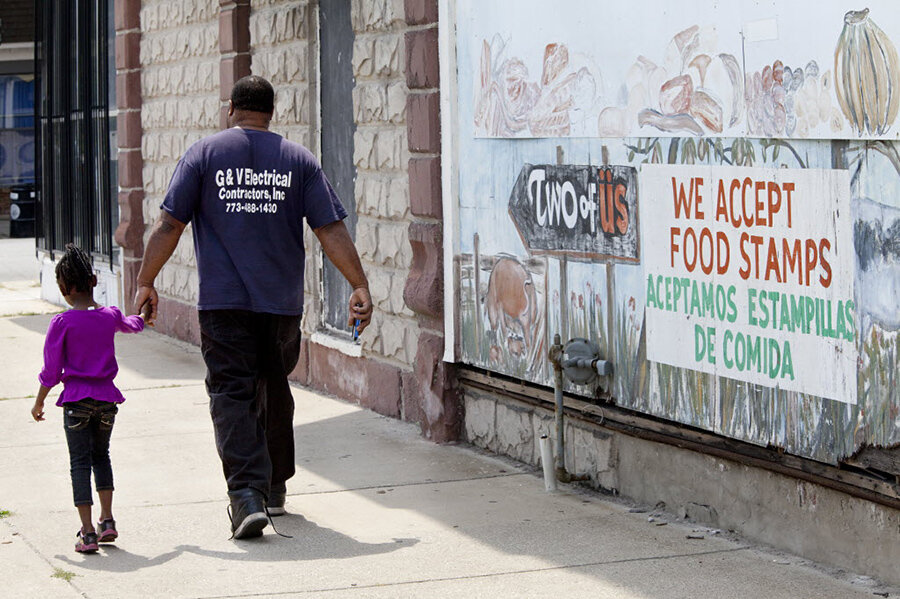How 10 text messages can help families find out if they qualify for food stamps
Loading...
A new texting-based system aims to simplify the process of applying for food stamps in Alaska, where 27 percent of people who are eligible for a common federal program that helps people buy food they need aren’t getting the benefits because they haven’t applied, state officials say.
Using text-based prompts, the system lets families see whether they would qualify for the federal Supplemental Nutrition Assistance Program in a series of 10 text messages, compared with a 28-page application that they would ordinary have to fill out.
“It really helps cut down on time for people, and it allows our specialists to let people know if they qualify right off the bat,” Kathleen Van Voorhies, director of food programs at the Food Bank of Alaska told local station KTUU.
The system, which works on any SMS-capable phone, is intended to provide a simple technological solution to the challenge of helping low-income people determine what types of services they qualify for.
Across the country, at least one member of nearly one in seven households did not have a consistent supply of adequate, nutritious food, a condition known as “food insecurity,” a 2014 survey by the US Department of Agriculture found.
In Alaska, local food banks have partnered with nonprofit Code for Anchorage and Chicago-based mRelief, which created the web- and texting-based mRelief Builder, to make the system available to families across the state.
If families find that they don’t qualify, they’re directed to a page offering more information about local food pantries.
“They might just see this one day and go, ‘Oh, I can text right now,' " Cara Durr of the Food Bank of Alaska told KTUU. “So from our perspective, it’s great. It’s connecting more people with the program and providing them with an important resource."
MRelief is currently being used in Chicago to help people determine their eligibility for a variety of other services in addition to food stamps, such as reduced price and free public transportation, Medicaid and Medicare Cost Sharing, and early learning programs for families with young children.
“Our mission is to restore dignity by transforming access to social services,” Rose Afriyie, mRelief’s co-founder, told KTUU.
In a tech industry that’s often struggled with questions about diversity, mRelief is unusual in being an all-woman team, created by Ms. Afriyie; Genevieve Nielsen, who serves as chief technology officer; and Marina Goldshteyn, the company’s product designer, who founded the company while they were students at a Chicago-based coding school.
The system, which serves low-income residents in Chicago, particularly on the city’s South Side, received 10,000 text messages in the first two weeks after it launched in the fall of 2014, Afriyie told the Chicago Tribune. More than 75 percent of text-message-based queries were about eligibility for food stamps, the company says.
Expanding the program beyond its home city, through a partnership with Code for Anchorage’s “co-captain” Brendan Babbit, was a logical next step, Afriyie told KTUU.
With more than 46.5 million people living in poverty in the US and as many as 11.8 million people eligible for the federal SNAP program, she says, mRelief could help a larger share of families put food on their tables. The company estimates that if all Alaskans who were eligible applied and began receiving benefits, the state would get about $66 million.
The program's unveiling in Alaska comes on the heels of President Obama’s recently released budget proposal, which pledged $12 billion over 10 years to create a permanent Summer Electronic Benefits Transfer for Children program that helps provide meals for children who receive free and reduced-price meals at school during the year but often lose those meals during the summer.
Families in Alaska can see whether they are eligible by texting the word “Hello” to (907) 312-2300 using a cellphone, including one borrowed from a family member or friend. In Chicago, texting “Hello” or another greeting to (773) 377-8946 will provide eligibility information about food stamps, early learning, and other programs. MRelief also began offering a version of the app in Spanish in December 2014.
“It’s really awesome to have cities like Anchorage participating," Afriyie told KTUU. “For us, it’s so exciting to help meet the needs in part of some of the most vulnerable citizens in the U.S.”







